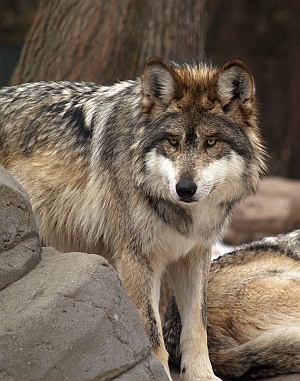Albuquerque, NM — The reintroduction of Mexican gray wolves to a mountain range just south of the US-Mexico border as part of an effort to re-establish the endangered species is off to a rocky start.
Correspondence between Mexican wildlife officials and the US Fish and Wildlife Service confirmed Tuesday that four out of the five wolves released by Mexico's Environmental Department last October are dead from poisoning.
Despite the deaths, supporters of wolf reintroduction in the American Southwest are still hoping releases in Mexico can provide a genetic boost to a small population of wolves in New Mexico and Arizona.
"They've been working for decades for this reintroduction so obviously this is setback, but my assumption and hope is that they will continue and make it successful," said Michael Robinson of the Center for Biological Diversity, an American group that has supported returning the wolves to their historic range.
The agency that oversees Mexico's natural resources and the environment released three female wolves — ages 11, 4, and 3 — and two 3-year-old male wolves in Sonora's San Luis Mountains in early October. The wolves went through rehabilitation in northern Mexico and were fitted with GPS collars so they could be tracked.
Mexico's reintroduction effort has been 20 years in the making. A release of captive wolves into the wild was first proposed in 2009 but faced delays.
As for the poisoned wolves, Mexican officials said one was found in November and the other three in December. Necropsies were done on all four animals and results in each case were positive for warfarin, a blood thinner that's used in rat poison and pesticide.
It was unclear whether the warfarin was set out intentionally for the wolves. Mexican officials did not provide any details about how the poison was consumed, and law enforcement agents were investigating.
The surviving female wolf is continuing to feed on rabbits and rodents in the area, according to officials.
Similar reintroduction work in the US started in 1998, but that program has been hampered by court battles, disputes between ranchers and environmentalists, livestock depredations and illegal shootings.
In the first year, five of the 13 wolves released in the US were shot. Now, there are at least 58 wolves in the wild in Arizona and New Mexico — more wolves than in each of the past five years.
Mexican officials have a recovery plan for the species and intend to carry on with the program, said Sherry Barrett, director of the Mexican gray wolf program in the US. "Any time we have this type of problem, we're disappointed," she said recently of the wolf deaths in Mexico. "But it's not insurmountable."
Neither Mexico nor the US has announced any specific plans for future releases to bolster their wild wolf populations.


